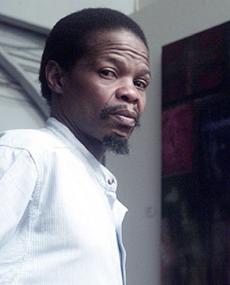
Fikile Magadledla, South African artist and co-founder of the Soweto Art Association, was born in Newclare, Johannesburg, on 13 December 1952.
As a young boy Fikile enjoyed boxing, but, when he left school in 1969, decided that he wanted to be an artist. Although he trained with renowned artist Bill Ainslie he was largely self-taught. He became a full-time artist in 1973 and mostly painted figures, flowers and landscapes using acrylic paint, pencil and mixed media. He also sculpted and while his earlier works were in terracotta and gas concrete, he later created pieces in iron. He also illustrated several books and wrote poetry to accompany some of his own paintings.
Fikile has been described as a man who "protested with pen and brush". Much of his work contains an element of resistance to a society built on apartheid, but during the late 1970s he explored more mystical topics like African mythology.
Fikile died in Johannesburg in 2003 after a long illness. Kgosistile Keorapetse, a colleague and friend of Fikile said, "Fikile has left a legacy of social responsibility and caring for children". His works have been exhibited all over the world and he is survived by his ten children.
Exhibitions:
1973: Lidchi Art Gallery Johannesburg (group).
1978: Sharp Festival, Grahamstown (Festival Art Exhibition).
1979: Goodman Gallery Solo Exhibition (Exhibition of Drawings 1975-9).
1981: Gallery 21 (Haenggi Foundation National Art Competition Exhibition).
1982: National Museum and Art Gallery, Gaborone, Botswana (Art Toward Social Development An Exhibition of SA Art).
1985: FUBA (Creative Workshop; A Selection of Work by DisÂtinguished Black Artists).
Collections:
Pelmama Art Collection, Johannesburg.
South African National Gallery, Cape Town.
University of Fort Hare.
Universoty of the Witwatersrand.
University of South Africa (UNISA).